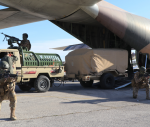You are here
Israel’s security calculus and Jordan’s emerging threat landscape
Apr 28,2024 - Last updated at Apr 28,2024
Following the most recent Israeli attack, both Iran and Israel seem to be formulating comprehensive security strategies aimed at safeguarding their borders and ensuring for international allies the protection of civilians ahead of the battle of Rafah. From the Israeli perspective, the heightened security measures taken by Israel in Lebanon and Syria underscore the critical importance to maintain their safety and stability. The proposed establishment of a security buffer zone to mitigate potential threats emanating from the southern Lebanese borders reflects the strategic considerations guiding Israeli decision-making.
This Israeli strategy is poised to exert increased pressure on Lebanon and Hizbollah, compelling them to confront the current situation head-on. With Israeli strikes targeting specific individuals and weapons caches, there is a distinct possibility of the creation of a buffer zone in southern Lebanon, hinting at a potential confrontation that may unfold soon.
The escalating tensions between Israel and Iran undoubtedly disrupt the proxy structure meticulously crafted by Iran in Syria over recent years. Israel’s targeted actions against Hizbollah, coupled with the consequent need for Hizbollah to respond, are prompting the group to recall fighters and shift assets from Syria back into Lebanese territory.
This shift in dynamics will have far-reaching implications across the Syrian theatre, particularly as various terrorist groups, including Daesh, may seek to exploit the situation to escalate hostilities. A recent incident orchestrated by Daesh near the city of Homs resulted in the deaths of at least 21 pro-Syrian militia members. Similar scenarios may unfold with groups like HTS, which have significantly intensified their operations in southern Idlib.
Furthermore, in both Syria and Iraq, Iranian-backed paramilitary groups have launched attacks against US forces. This development underscores the deep-seated internal divisions within the Iraqi Shiite community, with extremist factions advocating for continued attacks on American targets while others desperately seek to maintain a fragile truce to avoid further escalation. These fractures within the Shiite front are likely to escalate to violence against US assets in the short term and may culminate in sporadic clashes among various militias affiliated with groups like Kataib Hizbollah, particularly in densely populated urban centres.
As tensions mount and regional dynamics evolve, Lebanon emerges as the next focal point where Israel must adopt a systematic and comprehensive approach to neutralise threats emanating from the southern part of the country over the long term. Conclusively resolving the conflict in Gaza by controlling the geographic borders of Rafah, Israel’s strategic focus is steadily shifting towards Lebanon, as it endeavors to safeguard its geographic borders to further its national security interests.
This regional situation is increasing the pressure on Jordan, particularly evident through escalating verbal confrontations and accusations in Iranian propaganda. The security risks stemming from Syria and Iraq are significant, and there are indications that external forces may seek to agitate Jordanian society. Following the recent Iranian attack, which violated Jordanian airspace, there is heightened concern regarding the potential replication of such methodologies by unknown groups targeting sensitive assets. Hence, it is imperative for Jordan to exercise heightened vigilance against risks emanating from both Syria and Iraq, while also addressing internal security challenges effectively.














Add new comment